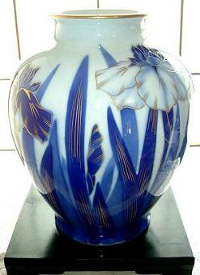Japanese Goods, flowing scents
from the traditional culture in Japan.
Pick up Items
Site Info
This is a free web app. Webアプリ
Add this button to your bookmark.
Imari Porcelain / Arita Porcelain
Imari Yaki / Arita Yaki, Japanese Porcelain
Imari Porcelain / Arita Porcelain (Imari Yaki / Arita Yaki) is a Japanese traditional porcelain, made in Arita, Saga Prefecture, Imari, Saga Prefecture. In the world, the word "Imari" is more famous than "Arita". The subject that the two words describe is the almost same. The porcelain has been fired around Imari and Arita, and exported from the Imari port, so people in abroad have called them Imari, and the Japanese have often called them Arita Yaki.
In the early 17th century, Lee Sanpei, who is a cratsman of porcelain and brought into Japan from Korea by the military of Hideyoshi, found the basic material of porcelain in Arita, and started to burn it. First, Imari can only porduce blue colors on porcelain, and it was called Sometsuke, and Japanese porcelain made in this era is especially called Early Imari style. Even today, you can enjoy a variety of Sometsuke in Imari Porcelain.
On the middle of 17th century, in Arita, craftsmen succeeded to produce a variety of colors without red colors, and start to produce multicolored porcelain. They are called Old Kutani style, which has impressed green colors and yellow colors. Today, you can enjoy this style of Japanese porcelain in Kutani Porcelain (Kaga, Ishikawa Prefecture).
In the late 17th century, Sakaida Kakiemon succeeded to describe red colors on porcelain, and start to paint Japanese porcelain by pictorial expressions. He established the original sense of the beauty, "the beauty of the white space on the margin", and it is called Kakiemon Style. In the same era, China got into confused internal affairs, and stop exporting porcelain to European countries. Alternatively, Imari started to export their porcelain and got the world reputation. Gold colored porcelain, Kinrande style, also established, and the best era came to Imari Porcelain. Even today, Kakiemon's descendant making wonderful porcelain.
From the middle of 18th century, Imari's exporting gradually reduced, and change the consumption to the domestic. Nabeshima Porcelain, the royal pottery of Nabeshima kingdom, produced the best grade of Imari Porcelain for presents to royalty and the aristocracy in Japan. Today, Imaizumi Imaemon succeeds the skills of Nabeshima Porcelain.
In the meiji period, after the Tokugawa government was over, craftsmen of Imari started to export their works again immediately, but with more developed technique absorbing European science, and more developed enterprise system imitating European companies. In Wien, Expo 1873, Imari Porcelain was awarded to the honor grand prize and established the world reputation (works). Today's companies of Imari Porcelain, such as Fukagawa Seiji and Koransha, originate here.
Today an artistic craftsman of Imari Porcelain, Inoue Manji, breaks through the traditions of Imari Porcelain. However, more movements of Imari Porcelain are expected, for example new materials or skills, new colors, shapes, and designs, new concepts of beauties, and etc.
